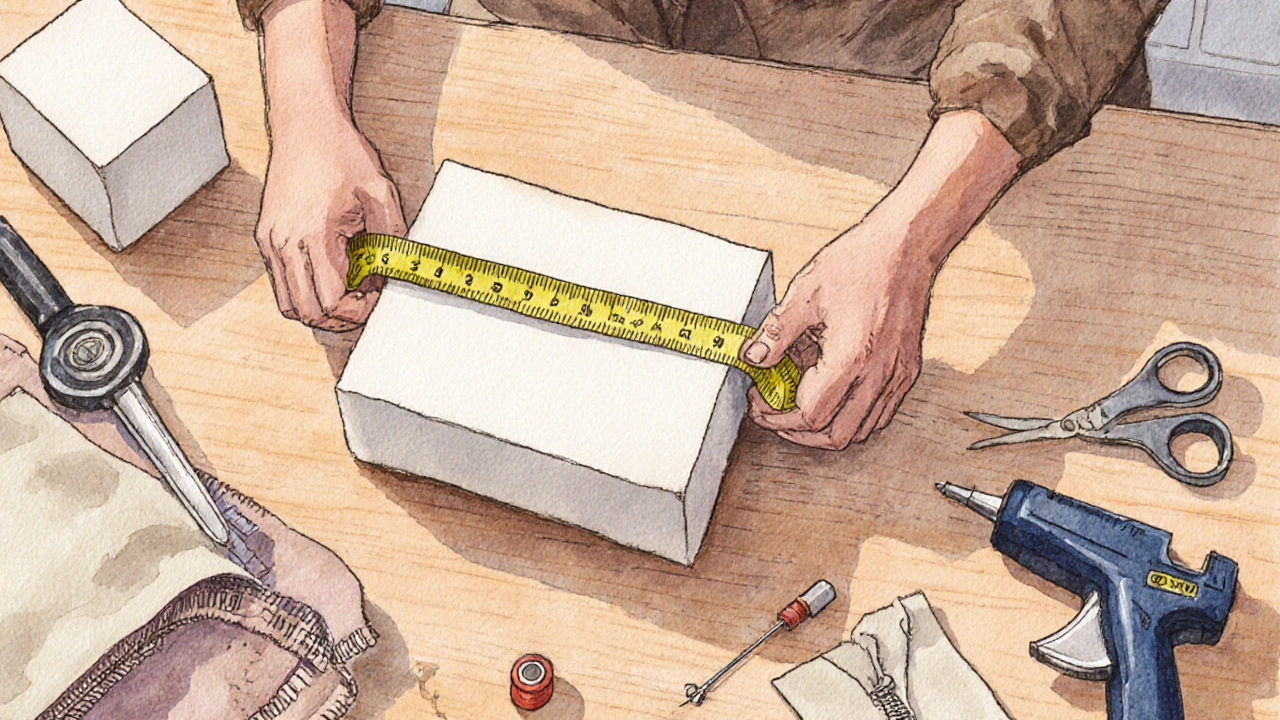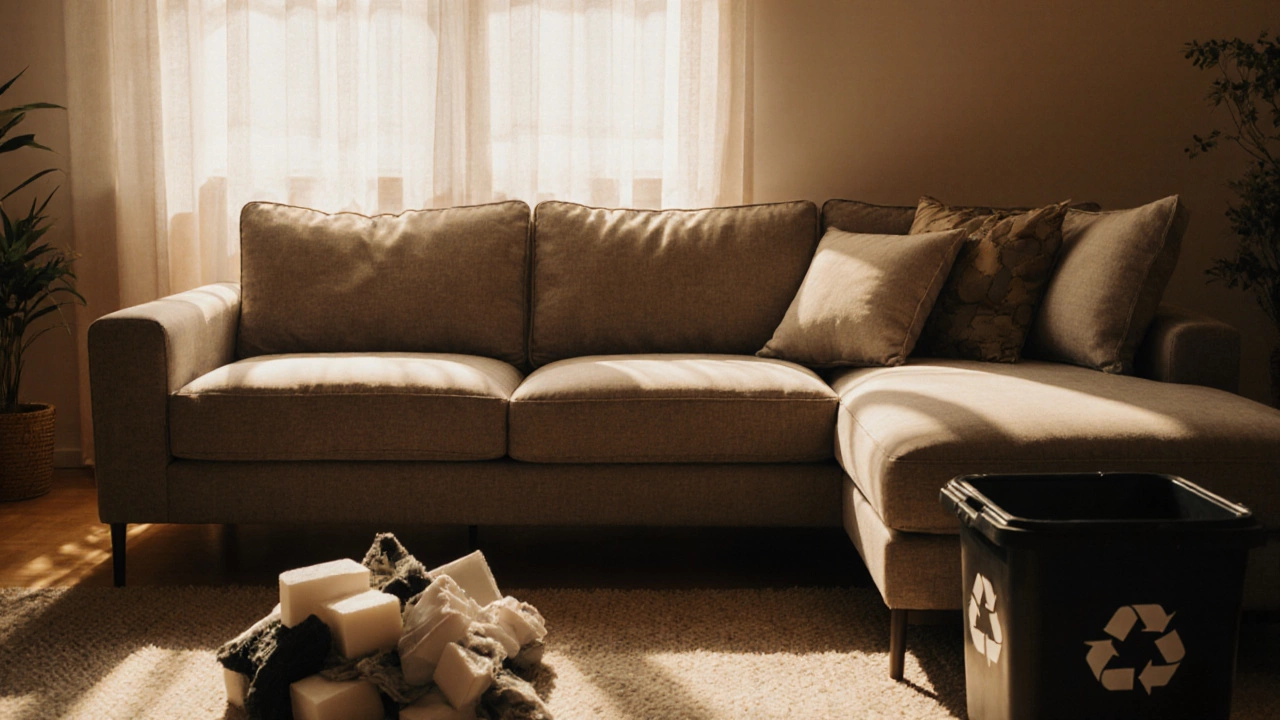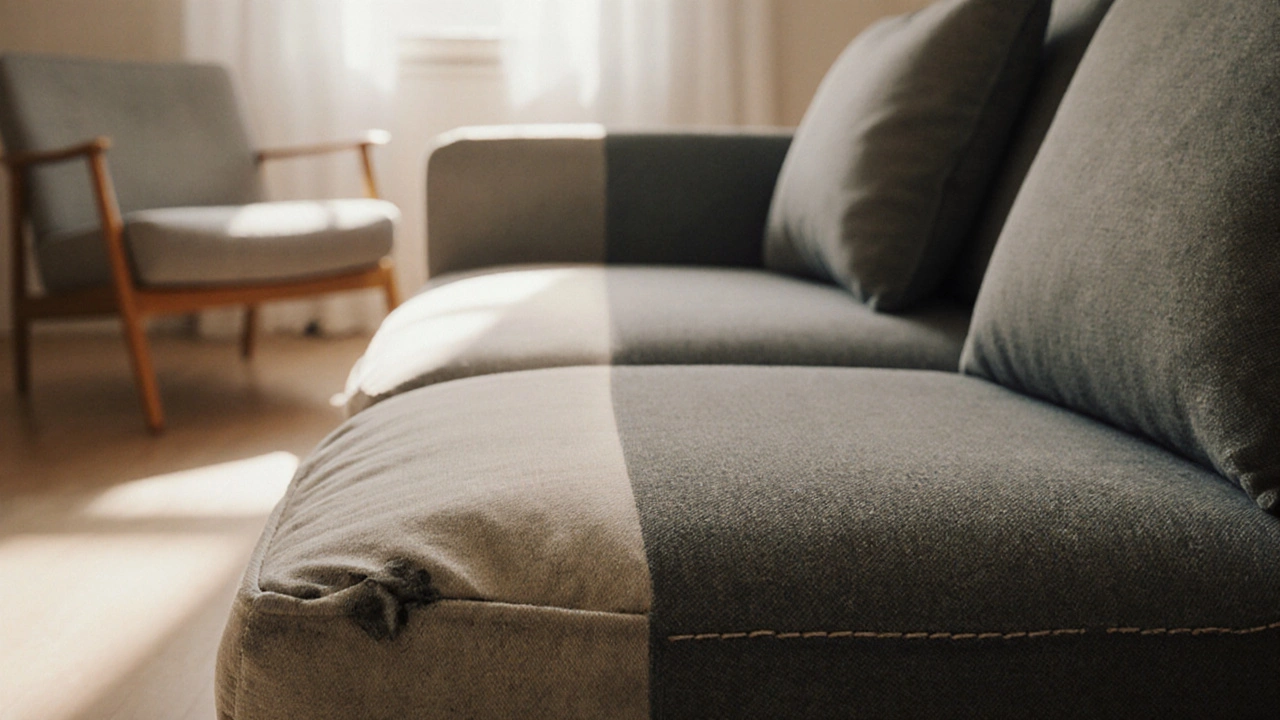Couch Cushion Replacement Cost Calculator
Estimate Your Project Cost
When a sofa starts to sag or the fabric looks worn, many wonder if they have to replace the whole piece. The good news is you can replace couch cushions without buying a new sofa. Couch cushions are the removable padding units that sit on the frame and give a seat its shape and comfort. They typically consist of a foam core wrapped in fabric and often feature a zippered opening for easy removal.
Why replace just the cushions?
Swapping out the cushions can revive a faded look, fix uneven wear, and extend the life of a favorite sofa. It’s also cheaper: a set of new cushions costs a fraction of a full reupholstery job. If the couch frame is still sturdy, there’s no need to touch it.
What you’ll need
- Upholstery foam - medium‑density is a safe bet for most sofas.
- Fabric cover - pick a durable weave that matches your décor.
- Measuring tape, marker, and scissors or a foam cutter.
- Staple gun with 1/4‑inch staples (optional for a tighter fit).
- Zippered cushion sleeves or a DIY zip kit if your existing cushions lack a zip.
- Heavy‑duty thread and upholstery needle.
Step‑by‑step replacement guide
- Take out the old cushions. Locate the zip or pull the cushion off the frame. If the cushion is glued, gently loosen the edges with a flat tool.
- Measure the interior. Use a tape measure to record length, width, and depth of the cushion cavity. Write the numbers down; you’ll need them for the foam cut.
- Cut the foam. Lay the Upholstery foam on a flat surface. Mark the dimensions and cut with a sharp knife or electric foam cutter. For a plush feel, consider a two‑layer approach: a firmer base topped with a softer layer.
- Sew a new cover (or reuse the old one). If you’re using fresh fabric, cut four panels - front, back, and two sides - leaving a 2‑inch seam allowance. Sew the panels together, leaving one side open for the foam insert. Install a sturdy zipper along the open edge.
- Insert the foam. Slide the cut foam into the sewn cover. Adjust until it sits evenly. If the cover feels loose, add a few strips of batting around the edges.
- Secure the cushion. Zip the cover shut. For extra hold, place a few staples through the fabric into the cushion’s inner board (if present). Make sure staples are flush to avoid tearing.
- Put the cushion back on the sofa. Align it with the frame’s slots or attach it with the original straps. Sit down and test for comfort and stability.

Cost breakdown
Replacing cushions is budget‑friendly. A typical set of medium‑density foam (four cushions) runs £30‑£45. Fabric prices vary widely; a durable upholstery cotton can be £8‑£15 per metre. A zip kit and staples add another £5‑£10. In total, most homeowners spend under £120, compared with £500‑£1500 for a full reupholster.
When to consider a full reupholstery
If the couch frame shows cracks, the springs are squeaky, or the wooden beams are warped, a cushion‑only swap won’t solve the problem. Below is a quick comparison to help you decide.
| Aspect | Replace Cushions Only | Full Reupholstery |
|---|---|---|
| Cost | £80‑£130 | £500‑£1500 |
| Time needed | 1‑2 days | 1‑2 weeks (professional) |
| Impact on frame | No change | Can reinforce or replace weakened parts |
| DIY friendliness | High | Low (often requires specialist tools) |
| Result durability | 5‑7 years (if foam quality is good) | 10‑15 years (when frame is solid) |
Common pitfalls and how to avoid them
- Choosing the wrong foam density. Too soft and the cushion will flatten quickly; too firm and it feels hard. Aim for a medium‑grade foam (30‑40 kg/m³) for most living‑room sofas.
- Skipping the zip. Without a zip, removing the cushion later becomes a chore. Install a heavy‑duty zipper that can handle repeated opening.
- Measuring incorrectly. Measure twice, cut once. Add a half‑inch extra for foam shrinkage.
- Using low‑quality fabric. Look for upholstery‑grade cotton, linen, or blended fabrics that resist pilling and fading.
- Neglecting the cushion’s inner lining. Many cushions have a thin plywood or fiberboard base. Replace it if it’s cracked; otherwise, the new foam may sag.

Pro tips for a professional finish
- Press the foam with a rolling pin before inserting it; this compresses any air pockets.
- Use a staple gun with a narrow staple for a cleaner look when attaching fabric to a wooden base.
- If you love a plush feel, add a 5‑mm layer of high‑resilience foam on top of the main core.
- Match the thread colour to the fabric for invisible stitching.
- Consider adding a thin sheet of batting between foam and fabric for a smoother surface.
Environmental impact
Replacing only the cushions reduces waste. Old foam can be recycled at many local councils, and fabric scraps can be donated to craft groups. By extending the sofa’s life, you cut down on the carbon footprint associated with manufacturing a whole new piece of furniture.
Next steps
If you’re ready to tackle the project, start by pulling the current cushions out and measuring the cavity. Gather your tools, order foam and fabric, and set aside a weekend. Should you hit a snag-like a broken frame or a stubborn zip-consider calling a local upholstery professional for a quick fix.
Can I replace couch cushions without a zip?
You can, but it makes future removal harder. A zip gives easy access for cleaning or swapping. If the original cushion has no zip, you can sew one in or use a Velcro flap as an alternative.
How often should I replace sofa cushions?
Most manufacturers recommend a refresh every 5‑7 years, depending on usage and foam quality. Heavy‑use sofas may need new cushions sooner.
Is DIY cushion replacement safe for antique sofas?
For antiques, proceed cautiously. Use gentle tools, avoid drilling into original wood, and consider consulting a professional upholsterer to preserve value.
What foam density is best for a lounge sofa?
A higher density (40‑45 kg/m³) offers firmer support for longer sitting periods. Pair it with a softer top layer for comfort.
Can I use foam from a mattress as a cushion insert?
It’s possible, but mattress foam is often too soft and may not hold shape under regular use. Upholstery‑specific foam is engineered to retain its form.
